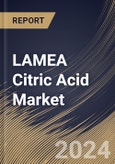Citric acid, with the chemical formula C₆H₈O₇, is a weak organic acid found in citrus fruits, particularly lemons and limes. It belongs to the alpha hydroxy acid group and is widely recognized for its sour taste and preservative properties. While natural sources provide a portion of the acid, the majority is produced through fermentation of sugars by various strains of the fungus Aspergillus niger. This biotechnological process has become a cornerstone in the production, ensuring a stable and cost-effective supply for diverse industries.
High demand for the goods to preserve food is expected to drive the industry's growth. In addition, the growing demand for compounds in the pharmaceutical industry to manufacture digestive medicines is expected to drive the market positively over the projection time. It imparts tartness & sourness and improves flavors. When used as an additive in food products, the acid effectively inhibits microbial development, extending their shelf life. The aspects above are expected to augment product needs over the coming years.
Similar to global trends, there is a growing preference for clean-label and natural ingredients in the LAMEA region. According to the US Department of Agriculture, the UAE imported $12.5 billion in consumer-oriented products in 2022, accounting for 59 percent of total Agricultural imports. The consumer-oriented industry in the UAE has seen a surge in the need for processed foods and snacks due to changing lifestyles and preferences. It is used in these products for its preservative properties and ability to enhance flavors. It is employed in the confectionery industry to provide a sour or tart taste in candies, gummies, and other sweets. The growing sector for confectionery products in the UAE has led to increased usage of this acid. As a result, these aspects will boost the market growth in the coming years.
The Brazil market dominated the LAMEA Citric Acid Market, By Country in 2022, and would continue to be a dominant market till 2030; thereby, achieving a market value of $110.5 Million by 2030. The Argentina market is showcasing a CAGR of 7.3% during (2023 - 2030). Additionally, The UAE market would register a CAGR of 5.7% during (2023 - 2030).
Based on Form, the market is segmented into Powder, and Liquid. Based on Application, the market is segmented into Food & Beverages, Pharmaceutical, and Others. Based on countries, the market is segmented into Brazil, Argentina, UAE, Saudi Arabia, South Africa, Nigeria, and Rest of LAMEA.
List of Key Companies Profiled
- Pfizer, Inc.
- Tate & Lyle Plc.
- Cargill, Incorporated
- Archer Daniels Midland Company
- Jungbunzlauer Suisse AG
- HUANGSHI XINGHUA BIOCHEMICAL CO.LTD.
- RZBC Group CO., LTD.
- Kenko Corporation
- Gadot Biochemical Industries Ltd.
- Citribel N.V.
Market Report Segmentation
By Form (Volume, Kilo Tonnes, USD Billion, 2019-2030)- Powder
- Liquid
- Food & Beverages
- Pharmaceutical
- Others
- Brazil
- Argentina
- UAE
- Saudi Arabia
- South Africa
- Nigeria
- Rest of LAMEA
Table of Contents
Companies Mentioned
- Pfizer, Inc.
- Tate & Lyle Plc.
- Cargill, Incorporated
- Archer Daniels Midland Company
- Jungbunzlauer Suisse AG
- HUANGSHI XINGHUA BIOCHEMICAL CO.LTD.
- RZBC Group CO., LTD.
- Kenko Corporation
- Gadot Biochemical Industries Ltd.
- Citribel N.V.
Methodology

LOADING...








